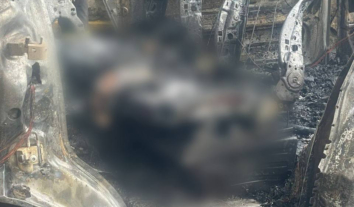Over 27% of detainees were women, 20% from vulnerable groups: International Partnership for Human Rights on Kherson Detention Facility
Over 27% of those unlawfully detained by occupying forces in Kherson’s temporary detention facility were women, and at least 20% belonged to vulnerable categories, including the elderly and individuals with disabilities, according to a report by the Belgian non-governmental organisation, the International Partnership for Human Rights (IPHR).
 Kherson Temporary Detention Facility
Kherson Temporary Detention FacilityThe report is based on the testimonies of 59 victims gathered by human rights defenders during field missions in the Kherson Oblast.
According to IPHR data, Kherson’s population decreased from approximately 300,000 to 66,000 during the war. The city was occupied by Russian forces in early March 2022 and liberated by Ukrainian armed forces in mid-November 2022. In opposition to the aggressor nation’s occupation, city residents held mass peaceful protests and organised an underground resistance movement. To suppress this resistance, the Russian occupying authorities established 10 places of deprivation of liberty in Kherson. People were subjected to torture there to force their submission or cooperation. One of the largest torture sites was the Kherson Temporary Detention Facility, located at 3 Teploenerhetykiv Street. Russian security forces held between 400 and 500 civilian prisoners there, whom the occupiers considered a threat.
“In the Kherson Temporary Detention Facility, the vast majority of victims suffered various forms of sexual violence, including electric shocks to the genitals using a military field telephone TA-57, known as a ‘tapik’,” the report states.
According to preliminary findings from OSINT and witness accounts gathered by IPHR, the detention facility was initially under the control of the Russian National Guard (Rosgvardia), and later the Russian Ministry of Internal Affairs and the Federal Security Service (FSB).
From March 2023 to August 2024, representatives of the Belgian organisation conducted 12 field missions in the Kherson region, during which they interviewed 59 witnesses. The human rights defenders found that the Russian occupying authorities in Kherson primarily detained men aged 30 to 50, the working-age population perceived by the occupation regime as the greatest threat.
“Over 27% of those detained were women, and over 20% belonged to vulnerable groups such as the elderly and persons with disabilities. Forty-five of the 59 detainees were accused of artillery spotting or other forms of armed resistance to the Russian occupation. At least 44 prisoners were detained for their pro-Ukrainian stance or non-military professional activities that were perceived as a potential threat to the occupation regime,” the IPHR report notes.
According to IPHR, 22 prisoners were detained for their loyalty to Ukraine. Another 22 people were abducted for providing humanitarian aid, activism, journalistic activities, and participation in local self-government.
As ZMINA previously reported, so-called “women’s cells” were set up in the Kherson Temporary Detention Facility. Researchers from the ZMINA Human Rights Centre established that at least thirty women were held in the detention facility at various times. They were detained during the summer, mostly in July and August 2022, and held until the end of October, when Russian forces began their retreat from the right bank of the Kherson region.
The detained women were suspected of, among other things, partisan activities and assisting the Armed Forces of Ukraine. Specifically, female employees of Ukrainian law enforcement agencies were deliberately targeted. People suspected by the Russian Federation of having contact or family ties with representatives of Ukrainian law enforcement agencies, the Armed Forces of Ukraine, or the resistance movement in the temporarily occupied territories of the Kherson region were also detained.
Among the women held in the Kherson Temporary Detention Facility were a former “Right Sector” volunteer who assisted in a military hospital, an employee of the Kherson Regional Communal Emergency and Rescue Service, a personnel officer of militarized security, a housewife, a cadet of the Ivan Kozhedub Kharkiv National Air Force University, an employee of the Patrol Police Department, and a deputy director of a gymnasium.
Another category of detainees was those used as hostages to apprehend family members, relatives, and acquaintances.
Russians also tortured Ukrainian women, particularly those professionally connected with Ukrainian law enforcement agencies or the Armed Forces of Ukraine, or those whom Russian representatives suspected of having ties to the Ukrainian resistance movement. Women were most often tortured with electric shocks, water, and beatings. There is also a known case of sexualized torture, where the victim was electrocuted on the chest. Threats of violence were also used.
ZMINA continues to report on the ongoing international crimes in the Kherson Oblast.








